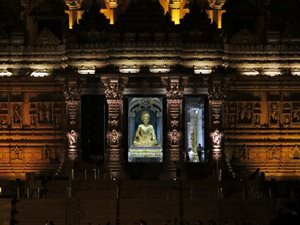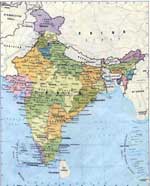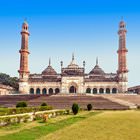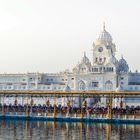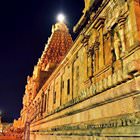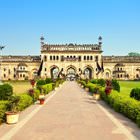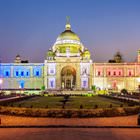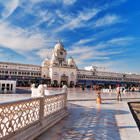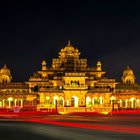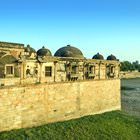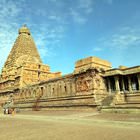Architecture of India. Must see and must visit landmarks
Akshardham, New Delhi
Location on the map:  Interesting facts:
Interesting facts:
» Akshardham is a modern Hindu Temple built in 2005. It is the biggest temple complex in the world that was even registered in the Guinness Book of Records. » The total area of the complex is 12 hectares. The construction cost half a billion dollars of donations.
» Akshardham was built by 7 000 workers. When it was being built, modern construction materials, for example, cement or metal, were not used. The facade was manually finished with pink stone from the outside and white marble from the inside.
» The temple is decorated with 9 domes and 20 pyramidal towers. The construction is supported by 234 columns with ornaments and patterns painted manually. In the halls, there are 20 000 statues. There are a lot of statues of elephants that totally weigh 3 000 tons.
» The main statue of the temple is the statue of Nilkanth Varni (1781-1830) that is 3 m high. He is also known as Bhagvan Swaminarayan. He was the founder of the religious movement. His relics are kept here. Everyone can enter the temple absolutely for free.
Building of High Court, Bombay
» 75 officials can simultaneously conduct trials at the court. More than 300,000 cases were conducted during the time of its existence.
» The exterior of the building resembles a European medieval castle. The only difference is that it’s surrounded by palm trees. It’s an elongated square that is 171 metres long. High walls prop a pyramidal roof. It’s covered with red tiles.
» The building has a strict appearance. But two eight-angle picturesque towers at the top of it stand out from the rest of the exterior. They are decorated with pointed triangular gables.
» The sculptures of goddesses are signs of justice and mercy. There’s a one-eyed monkey among them. It plays with scales of justice.
» Various exhibitions are held here. For example, an exhibition of Indian postage stamps, geographical maps. To celebrate the 150th anniversary of the court, a permanent exhibition of court-related items and written testimony having a historical value was organized in the central hall.
» The building has a spacious field where you can play cricket (a game with a ball and a bat).
Cathedral Church of the Redemption, New Delhi
» The building is decorated with dark scarlet stone. The color gradually changes and creates a gradient going from the roof and reaching triangular porticoes under the base of the bell tower.
» The church is located near the Parliament House in the central district of Dehli. The church fits harmoniously into the space composition of other buildings.
» The outer walls are painted red. With it, the church symbolizes the blood of Christian martyrs. They were citizens dying during the Sepoy Rebellion when Indian soldiers rose against the English colonial policy.
» The luxurious interior of the church decorated with paintings and carved figurines has been preserved. The walls are stained glass. Everything looks quite modest. It is always cool inside.
» The Cathedral Church of the Redemption in New Dehli (India) has been well preserved. There is a natural grass lawn around the church. The doors of the church are always open to visitors.
Central railway station, Bombay
» The English started to build the railway from Bombay so far into the country in the middle of the 19th century.
» The building itself was constructed in 1876. It was completed at the date of the 50th Anniversary of Victoria’s reign. The construction lasted 9 years.
» The railway station is still open for tourists. It is the final destination point of the city Bombay Railway. This is the only railway, by which you can travel from one district to another.
» Not so long ago, the railway station received the name of the national hero of the 17th century, Chhatrapati Shivaji Terminus, or CST.
» It features a mixture of different architectural styles: New Gothic, Italian, and Indian. With its exterior, the building resembles a luxury palace but not a strict state institution.
» It is also characterized by carved wood, sculptures, railings, and grids decorated with patterns. The walls are faced with ceramics. There are many towers and arched hallways.
Gateway of India, Bombay
Location on the map:  Interesting facts:
Interesting facts:
» In December 1911, King George V made a friendly visit to Bombay. The Gateway of India was constructed in commemoration of this event. » The construction lasted 13 years. It was completed with the festive opening ceremony in 1924.
» The Gateway of India has a historical value, as soldiers of the British Army left the country through it.
» It was made of yellow basalt stone. The big arch is carved in it. The Gateway is decorated with multiple pictures. It is located on the embankment of Mumbai (Bombay).
» The giant triumphant arch is 26 m high. Its exterior facade is characterized by the combination of different architectural styles: Muslim, Indian, and Jewish. The massive platform ends with towers. The foundation of the platform continues with the steps leading to the water.
» The Gateway is covered with the dome that is 15 m high and has a diameter of 25 m. The arch at the sides has free recesses. They accommodate 600 people.
» Traditionally, ships and governors of India go through the Gateway.
» According to one legend, if you enter the Gateway with good intentions, the city will be hospitable to you. Say goodbye to the citizens in thoughts when leaving the megacity.
Humayun Tomb, New Delhi
Location on the map:  Interesting facts:
Interesting facts:
» Humayun's tomb was built 14 years after his death. The Emperor died as a result of the accident when he fell down the stairs. » The wife of Humayun ordered to build a mausoleum. The construction lasted 8 years and was completed in 1570. This grand tomb consists of several constructions surrounded by the Char Bagh Gardens.
» The grace of Humayun is under the main hall of the mausoleum. In the hall itself, visitors can see a cenotaph (sarcophagus). Near it, there are marble sarcophagi of Humayun’s wives.
» In the territory of the tomb, about 150 people who were close to Emperors were buried. Bahadur Shah, the last Mongolian emperor, was captured by Englishmen.
» The construction was renovated in the period between 1999 and 2003. Humayun’s tomb is the first mausoleum in India. It is a UNESCO World Cultural Heritage site.
India Gate, New Delhi
Location on the map:  Interesting facts:
Interesting facts:
» The India Gate is a stone arch constructed in honor of Indian soldiers dying during the war against Afghanistan and the First World War. 90 000 names of soldiers are written on it. The monument was projected by the British architect Edwin Lutyens. The construction lasted 10 years and was completed in 1931. An eternal flame constantly burns here. In 1971, Indira Gandhi festively opened the Monument to the Unknown Soldier when the Indo-Pakistan ended. Nowadays, this memorial is a place where a lot of festive events and parades are held. In the evenings, the monument is beautifully illuminated. There is a park around the monument. A lot of people come to relax here. Since 2011, the International Kite Festival that attracts thousands of spectators has been held in the park. Jama Masjid, New Delhi
Location on the map:  Interesting facts:
Interesting facts:
» The Jama Masjid in Delhi was founded by Shah Jahan in 1650-1656. Upon his order, the Taj Mahal, the mausoleum of his wife, was also built. » The Jama Masjid is one of the largest mosques in the world. Its courtyard can accommodate up to 25 000 believers. The mosque was built by 5 000 builders.
» Some time later, it was ordered to destroy it. A new mosque started to be built in 1775. The construction lasted until 1802.
» In the temple, the historical relic - the Quran written on deerskin - is kept.
» Everyone can enter the minaret that has a view of the entire city for a fee.
» In April 2006, during the Muslim holiday, two bursts occurred in the mosque. 13 people were injured. However, the mosque was not damaged.
Jawaharlal Nehru Stadium, New Delhi
Location on the map:  Interesting facts:
Interesting facts:
» Jawaharlal Nehru Stadium is a big stadium for football matches, other sports competitions, and concerts in Dehli. » The stadium can accommodate up to 60 000 visitors. During festive events, it accommodates 100 000 spectators.
» It is the headquarters of the Indian Olympic Association that presents the country in the Olympic Games. The sports stadium was opened in 1982.
» It was named after the Prime Minister of independent India Jawaharlal Nehru. Here, football teams, cricket players, and athletes train. Basketball, volleyball, and table tennis competitions are held on the other playground.
» The field is 106x68 m. The sports stadium was reconstructed by the 19th Commonwealth Games. The renovation lasted 3 years. A canopy was added. For these games, a swimming pool was constructed. It cost $85 million.
» Jawaharlal Nehru Stadium is depicted on a postage stamp. You can enter its territory only during competitions or festive events. At other times, the stadium is not open to the public.
Lotus Temple, New Delhi
Location on the map:  Interesting facts:
Interesting facts:
» The Lotus Temple, or the Bahá'í House, is one of the nine temples built all over the world. It belongs to Bahái followers. It is modern religion that lacks confessional restrictions, sermons, priests, and altars. Adherents to this religion don’t worship icons and sculptures. » The huge white building that resembles a lotus flower was built in 1986 on the donations collected all over the world. The project architect was Fariborz Sahba, an Iranian who lived in Canada.
» Before the construction, the building project had been modeled on the computer for two years. The main hall that has a diameter of 75 m and is 31 m high can accommodate from 1 300 to 2 500 visitors. The Bahá'í House was awarded several architectural prizes.
» In Bahá'í temples, adherents of any religion can pray. Here, volunteers serving visitors and the temple work.
» Over the years of its existence, the temple was visited by more people than the Taj Mahal or the Eiffel Tower was.
Mumbadevi Temple, Bombay
» The Mother Goddess defended salt miners and patronized anglers. They were the main group in the city.
» There is the two-meter statue of Mumba in the temple. It is made of black stone. Its head is decorated with a silver wreath. There are golden rings on the fingers and toes and a precious necklace on the neck. The figure is dotted with orange and yellow marigold leaves.
» The idol is surrounded by other goddesses. One of them is riding a peacock. Near it, there is the statue of the simian creature and the god of wisdom and wealth.
» The sanctuary is modestly decorated. There are almost no decorative elements. The rectangular temple is built of white stone. There is a tower in the tower of the pyramid at the top. There is a flag atop. Massive vertical ledges are the foundation of the construction.
» The entrance to Devi’s room is guarded by a sculptural tiger. The goddess rode it.
» Unlike the interior, the exterior of the temple impresses with plenty of intricate elements.
» Mumba has been revered since the 15th century.
Parliament House, New Delhi
Location on the map:  Interesting facts:
Interesting facts:
» The Parliament House was built by English architects Edwin Lutyens and Herbert Baker in 1911. It is the most extraordinary Parliament building in the world. » It is a round construction surrounded by columns. The roof of the building is supported by 144 columns. If you circle the Parliament House, you will cover 1 km.
» The Parliament House started functioning in 1927.
» In the center of the construction, there is a big round conference hall with a domed ceiling and walls faced with wooden panels.
» Remarkably, men putting costumes of langurs were invited to protect the building from monkeys. Workers produced creepy sounds to keep these arrogant beasts away.
» In 2001, a terrorist group broke into the Parliament House. Terrorists were struck down but seven people were murdered.
Qutb Minar, New Delhi
Location on the map:  Interesting facts:
Interesting facts:
» The Qutb Minar is one of the mosques built in the territory of the complex of historic buildings. It is considered as the highest mosque in the world. » It started to be built in 1193. The construction lasted 175 years. The last fifth tier was finished in 1368.
» The mosque is 73 m. The brick construction is decorated with beautiful delicate carving.
» The mosque stood the test of time and even several strong earthquakes. In 1993, the Qutb Minar was taken under UNESCO protection.
» Near the tower of the mosque, there is another interesting construction. This is a 7-meter column molded of iron 4 centuries ago. It is unique because it doesn’t rust. There is a hypothesis that the column was molded of cosmic iron.
Rajabai Clock Tower, Bombay
» The construction of the Rajabai Tower was conceived in 1869. It was hard to implement the design architecturally, therefore the construction lasted for ten years and was completed in 1878.
» The 85-metre tower and the library extension adjoining it are made of yellow and orange stone. It was brought from a suburban quarry.
» The tower consists of 3 parts: the lower one that is 20 metres high, the middle level with a clock, and the upper one ending with a statue instead of a spire. There are eastern figures on the facade. The first part of the tower has lots of stained glass windows. There are two rooms on the first floor. They are located opposite each other. A spiral staircase goes up from the lobby.
» An Indian businessman made a significant financial contribution to the construction. The tower is named for the millionaire’s mother. The clock is mainly used to determine what time it is. Eating after sunset is forbidden for religious reasons.
» The tower clock originally had 16 tunes. Nowadays, one melody plays every 15 minutes.
» The internal entrance is closed for safety reasons. In the past, many people committed suicide from there.
This article about architectural landmarks and sights of India is protected by the copyright law. You can re-use the content, but only under the condition of placement of an active link to www.orangesmile.com.
Fantastic City Tours and Excursions in India
Saudi Arabia to Open 38 Hotels in Diriyah
Diriyah is one of the first mega projects in Saudi Arabia. Hotels and other infrastructure will start opening next year, and all works are expected to end in 2026. The first 18 restaurants in Bujairi Terrace will start operating already in early 2022. Read this
Read this
27.04.2024
Diriyah is one of the first mega projects in Saudi Arabia. Hotels and other infrastructure will start opening next year, and all works are expected to end in 2026. The first 18 restaurants in Bujairi Terrace will start operating already in early 2022.
27.04.2024
Photogallery of India architecture
What to see in top cities of India
Walking in New Delhi's popular tourist districts, one can explore many more interesting features hidden from ordinary tourists. Cricket is the favorite sport for locals, and if you are lucky enough to visit New Delhi during one of the championships, you can take part in incredible celebrations. On the days of the match, all citizens take to the streets, improvised stages and street food stalls can be seen everywhere. Games of the national team are always a holiday for citizens, so it would be … Read more 
People rarely include such an add location as a post office to their touristic route through a new city. However, Mumbai General Post Office is definitely worth checking out, as it’s a historic landmark of the city. The main post office of the city was built in 1913 and occupies an area of 11,000 square meters. This luxurious colonial building houses not only the post office but the country's main telegraph office as well. The interior design of the building is also rather impressive. The … Read more 


 English
English Russian
Russian Nederlands
Nederlands Deutsch
Deutsch Español
Español Français
Français Türkçe
Türkçe